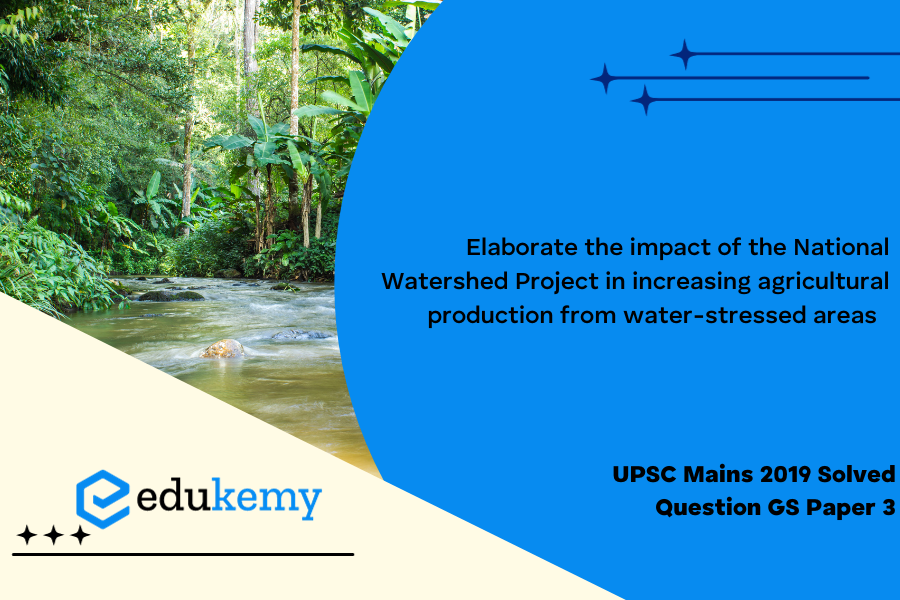The National Watershed Project stands as a transformative force in bolstering agricultural production within water-stressed regions, marking a crucial stride toward sustainable farming practices. By focusing on watershed management, this initiative has meticulously addressed the challenges posed by water scarcity, presenting a holistic approach that intertwines ecological health and agricultural productivity. Through the strategic implementation of soil conservation measures, efficient water harvesting techniques, and afforestation programs, the project has significantly mitigated the adverse effects of water stress on farmlands. The cascading impact is profound, as improved water availability enhances crop yields, safeguards against soil erosion, and cultivates a more resilient agricultural ecosystem. Moreover, the National Watershed Project has fostered community engagement and knowledge dissemination, empowering farmers with innovative practices that optimize water usage. As a result, the initiative not only contributes to increased agricultural output but also heralds a paradigm shift in resource management, ensuring the sustenance of farming communities in water-challenged areas.
Tag: Major Crops – Cropping Patterns in various parts of the country, – Different Types of Irrigation and Irrigation Systems; Storage, Transport and Marketing of Agricultural Produce and Issues and Related Constraints.
Contents
Decoding the Question:
- In the Introduction, try to write about water-stressed areas with data.
- In Body, elaborate impact of the National Watershed Project on agricultural production.
- Try to conclude with a suggestion.
Answer:
A region is said to be under ‘water stress’ when the water demand there exceeds the available volume or when poor quality restricts use. India placed thirteenth among the world’s seventeenth ‘extremely water-stressed’ countries, in the Aqueduct Water Risk Atlas of the World Resources Institute (WRI). The watershed project involves conservation, regeneration, and judicious use of all the resources like land, water, plants, animals, and humans within the watershed area.
- Extremely high levels of water stress mean an average of 80 percent of the available water in a country is used by irrigated agriculture, industries, and municipalities every year.
- In India, nine states and union territories (UTs) have been categorized as regions of “extremely high” water stress. Chandigarh tops the list that also includes Haryana, Rajasthan, Uttar Pradesh, Punjab, Madhya Pradesh and Gujarat.
- Both surface water and groundwater in India were highly exploited. Groundwater levels declined by more than eight centimeters per year between 1990 and 2014 in northern India.

Need for Watershed Management:
The National Watershed Project also known as Neeranchal National Watershed Project is a World Bank-assisted watershed management project. The objective of this project is to support the Integrated Watershed Management Program (IWMP) through technical assistance to improve incremental conservation outcomes for natural resources including water, soil, and forests while enhancing agricultural yields in a sustainable manner for farming communities.
It includes Prime Minister Krishi Sinchayee Yojna (Watershed Development Component) (WDC-PMKSY) and the Neeranchal Project.
- WDC-PMKSY: The main objectives of the WDC-PMKSY are to restore the ecological balance by harnessing, conserving, and developing degraded natural resources such as soil, vegetative cover, and water.
- This enables multi-cropping and the introduction of diverse agro-based activities, which help to provide sustainable livelihoods by increasing agri-produce.
- Neeranchal: Neeranchal is a World Bank-assisted National Watershed Management Project. It is designed to further strengthen and provide technical assistance to the PMKSY-WDC.
Impact of National Watershed Project on Agricultural Productivity:
- The project has led to a reduction of surface runoff thus increasing groundwater recharge, soil moisture, and better availability of water in water-stressed areas. It also helps farmers to better manage surface and groundwater resources.
- This has resulted in incremental agriculture productivity and increased cropping intensity through optimum utilization of natural resources like land, water, vegetation, etc.
- It will also help to mitigate the adverse effects of drought prevent further ecological degradation and support farmers in water-stressed areas to adapt to climatic change and ensure improved livelihoods for people.
- It helps in the restoration of ecological balance in the degraded and fragile water-stressed areas by increasing vegetative cover and decreasing soil erosion through afforestation and crop plantation.
- People’s involvement including the farmers and tribal people is the key to the success of any watershed management program, particularly the soil and water conservation. Successful watershed management has been done at Sukhomajri, Panchkula, and Haryana through the active participation of the local people.
- Better crop management: Water availability helps farmers to choose seeds and crops like HYV seeds which require substantial amounts of water. Helped to improve food production and productivity of agriculture.
- Transformation: The transformation of dryland agriculture into a vibrant and sustainable form of agriculture for example, the Thummachennupalle watershed in Chittoor district transformed into a community-owned orchard after NABARD implemented Neeranchal.
- Improved soil fertility: Reducing the impact of floods, which every year is used to destroy fertile layers of soil. It also helped farmers by availing water at any time to maintain soil moisture according to the needs of crops.
- Control desertification: Overuse of water increases the salinity of soil and reduces productivity. It is also the reason behind turning fertile land into desert and the process of desertification enhanced.
However, watershed projects face certain challenges such as very little community participation, lack of coordination between implementing departments and ministries, etc. Properly educating the people about the project and its benefits or sometimes paying certain incentives to them can help in effective people’s participation. Watershed Development on a large scale is the best solution to overcome water-stressed problems.
In case you still have your doubts, contact us on 9811333901.
For UPSC Prelims Resources, Click here
For Daily Updates and Study Material:
Join our Telegram Channel – Edukemy for IAS
- 1. Learn through Videos – here
- 2. Be Exam Ready by Practicing Daily MCQs – here
- 3. Daily Newsletter – Get all your Current Affairs Covered – here
- 4. Mains Answer Writing Practice – here


